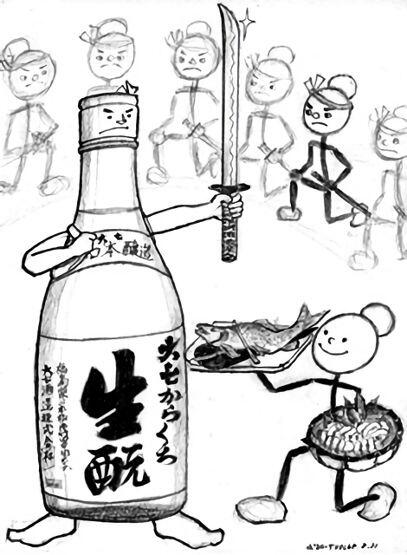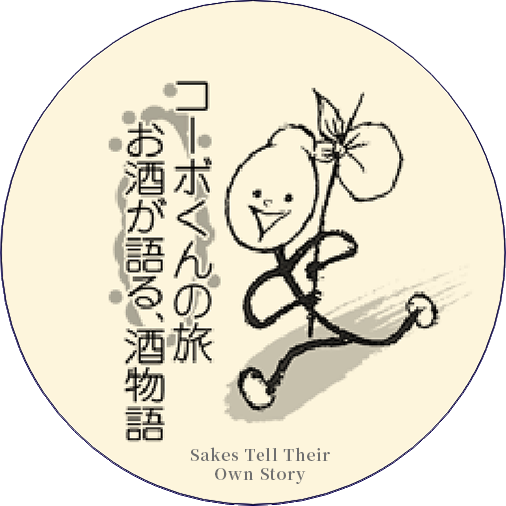| Yeast |
“I’m now going to visit Karakuchi Kimoto. Just like Kimoto and Junmai Kimoto, our relation goes back a long time. Hello!” |
| Karakuchi Kimoto |
“Welcome, Yeast. Ask me anything you want.” |
| Yeast |
“You, Karakuchi Kimoto, are a long-seller, one of Daishichi’s most popular products. When were you exactly born?” |
| Karakuchi Kimoto |
“First, Honjozo Kimoto was born in 1982, then Junmai Kimoto in 1983 and I followed in 1984. For a period of time, we were the so-called ‘Daishichi Kimoto Trio.’” |
| Yeast |
“From the start you were popular in Tokyo, not only locally.” |
| Karakuchi Kimoto |
“I suited the preference of the metropolis for dry sake. I was popular with restaurants for my sharp dryness combined with a satisfyingly deep taste, which was very different from the usual dry sakes which are rather watery.” |
| Yeast |
“How do you make dry sake? It’s not like black coffee where you simply leave out the sugar, I suppose.” |
| Karakuchi Kimoto |
“You should know that better than anyone else! The deciding factor in making dry sake is the fermentation power of the yeast.” |
| Yeast |
“Indeed! When we, yeast particles, are fermenting you, Karakuchi Kimoto, we are always completely worn out. But we fight as a team without any of us dropping out.” |
| Karakuchi Kimoto |
“That is typical of kimoto yeast. You change the sugars that are dissolved into the main mash into alcohol, but when the alcohol percentage rises, it becomes a cruel environment for you, yeast particles. When the yeast even then continues to reduce the sugars until the very end, you get good dry sake. But when on the other hand the yeast becomes over-strained, large part of it will die, and that leads to a bitter and harsh taste. That doesn’t happen with kimoto yeast, which overcomes this problem by its superb vitality.” |
| Yeast |
“Ahem! In contrast to modern yeast, almost none of the kimoto yeast dies. Therefore dry sake made with the kimoto method has a fresh and pleasant aftertaste.” |
|
 |
| Karakuchi Kimoto |
“On the Sake Meter Value (Nihonshudo), which indicates the degree of sweetness or dryness, and where a higher plus number indicates more dryness, I measure +8.” |
| Yeast |
“But you don’t have a dryness like shochu (Japanese distilled liquor), you are popular because of the high-quality umami you possess, which is typical for a fermented beverage. Which food goes best with you?” |
| Karakuchi Kimoto |
“Especially Japanese food. I go very well with a summer delicacy like salt-grilled ayu (sweetfish) or poached pike conger, especially when you drink me very cold as reishu. Delicious!” |
| Yeast |
“You make my mouth water! Karakuchi Kimoto, sometimes I feel you are more attractive than daiginjo!” |
| Karakuchi Kimoto |
“The compatibility of sake with food is something strange, it is not so that ginjo sakes are always more delicious. Therefore I keep refining myself on the basis of the way I am.” |
| Yeast |
“I understand now why you with your straightforwardness have become a solid long selling sake among Daishichi’s sakes with their many brilliant episodes. Are there any other interesting food matchings?” |
| Karakuchi Kimoto |
“In autumn and winter I go well with tempura of tiger prawns (kuruma ebi), or shabu shabu with sesame sauce. Of course, in these cases I should be warmed. My appeal is that my expression varies greatly depending on the temperature.” |
| Yeast |
“You really are a sake that highlights the food. Recently, you have also appeared in bottles of 300 ml.” |
| Karakuchi Kimoto |
“Yes, in that way it’s easier for individual customers to drink me during dinner at home.” |
| Yeast |
“Thank you very much. I’m your steady supporter!” |





